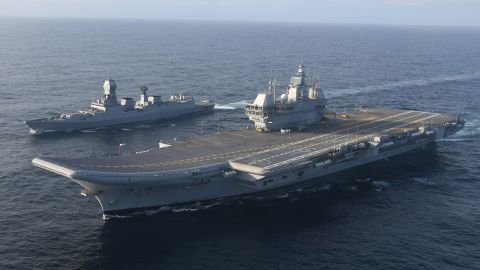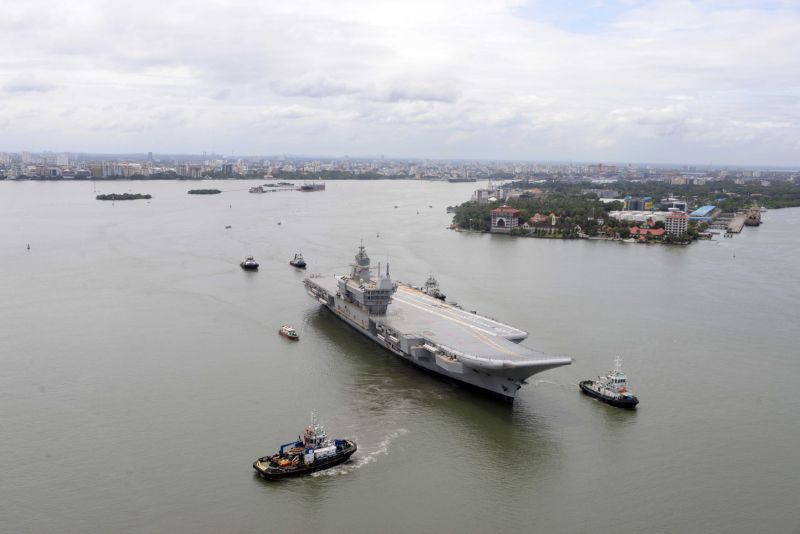New Delhi
CNN
—
On Friday, India will join an elite league of global naval powers, when it commissions its first domestically built aircraft carrier, INS Vikrant.
With the $3 billion Vikrant, India will join only a small number of countries with more than one aircraft carrier or helicopter carrier in service and become only the third country, after the United Kingdom and the China, to have commissioned a domestically built aircraft carrier in the past. three years.
Prime Minister Narendra Modi is expected to visit the Cochin shipyard in the southern state of Kerala for the launch ceremony of the carrier.
John Bradford, a senior fellow at the S. Rajaratnam School of International Studies in Singapore, said India’s commitment to the ship reflected its “long-term vision to maintain a world-class naval force”.
“There are looming questions about the survivability of any aircraft carrier in the missile age, but major navies – including those of the United States, Japan, China and the United Kingdom – are doubling down their investments in aircraft carriers. In that sense, India remains in the game,” Bradford said.
Vikrant joins carrier INS Vikramaditya, a refurbished Soviet-era carrier purchased from Russia in 2004, in the Indian fleet.
With a displacement of around 40,000 tons, the Vikrant is slightly smaller than the Vikramaditya and the carriers of the United States, China and the United Kingdom, although it is larger than that of Japan.
But analysts have praised its potential firepower.
When its air wing becomes fully operational over the next few years, Vikrant will carry up to 30 aircraft, including MiG-29K fighter jets – to be launched from its ski ramp-style deck – and helicopters as well as defensive systems , including surface to air-missile systems.
Powered by four gas turbine engines, its top speed is estimated at 32 mph (52 km/h) with a range of 8,600 miles (13,890 kilometres).
“India is sending the message that it has the power, it has the aircraft carriers and therefore the air power to dominate the far reaches of the Indian Ocean,” said Ajai Shukla, a former Indian military officer turned analyst of the defense.
Analysts said the new carrier, and the destroyers and frigates that will eventually make up its strike group, also provide India with more distant options.

“India can both influence and coordinate potential security solutions to regional problems. The contribution of a high seas capability naval task group adds to India’s influence and options. It does not need to join a multilateral response but can do so, or establish a separate independent presence, if it wishes,” said Carl Schuster, a former US Navy captain who now teaches at the Pacific University of Hawaii.
The new carrier will allow India to play a bigger role in military exercises through the Quadrilateral Security Dialogue, or “Quad”, an informal alliance of the United States, Japan, Australia and India.
For example, the American and Japanese carriers participated in the annual Malabar exercises in which members of the Quad participate.

Building Vikrant was not easy for India.
The government approved her design and construction in 2003 and the keel was laid in February 2009. The ship was christened Vikrant – which means “brave” or “victorious” in Sanskrit – and launched in August 2013.
But then delays set in: features had to be redesigned, there were problems securing Russia’s aircraft equipment, and then there was the Covid-19 pandemic.
Still, experts say India will be able to improve its domestic shipbuilding capability and learn from experience.
“They now have the expertise to build the next carrier faster and probably with a better design,” Schuster said.
The Indian Navy plans to build a second indigenous aircraft carrier. This remains in the design phase, but there has been speculation that any new carrier could be in the region of 65,000 tons, roughly the size of Britain’s HMS Queen Elizabeth or China’s second largest carrier Shandong. .
China is considered India’s main naval competitor in the region. With two carriers in operation and a much more advanced third carrier launched last year, China is ahead of India both numerically and technologically, but analysts give India the edge when it comes to experience operational carriers.
The Indian Navy started operating aircraft carriers in 1961. Its first aircraft carrier, which it acquired from the United Kingdom, was also called Vikrant. The first Vikrant was retired in 1997. A second British-built aircraft carrier, INS Viraat, served with the Indian Navy for 30 years before being scrapped in 2017.
China’s first aircraft carrier, the Liaoning, was an unfinished Soviet-era ship that Beijing bought from Ukraine in 1998, updated, and finally commissioned in 2012. Its first domestically built aircraft carrier, the Shandong, entered service in 2019 and in June 2022 it launched its third carrier, Fujian – an advanced carrier with electromagnetic catapult-assisted launch systems, similar to those used by the United States.
“On paper, the new Chinese carriers have more payload and technology capabilities than Vikrant. However, India has decades of experience in operating carrier air forces while China is still learning,” said Bradford, the Singapore analyst.
Even with that experience, it could take Vikrant a year or a lot longer to become fully operational as a fighting force. This is typical of aircraft carriers. The newest US carrier, the USS Gerald Ford, was commissioned in 2017 and is not expected to have its first deployment until later this year.

